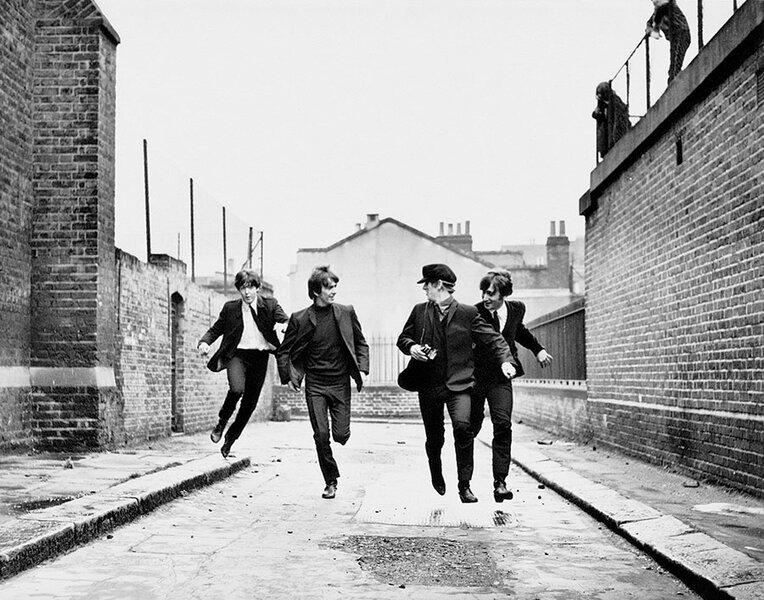'A Hard Day's Night': A re-release shows the movie has lost none of its joy
Loading...
“A Hard Day’s Night” is one of the very few movies that looks every bit as good now as the day it was made. I first saw it as a preteen on vacation with my parents in Ireland. The atmosphere inside the theater – a gleeful pandemonium – was, I imagined, pretty much like the atmosphere at a live Beatles concert.
The joyful rush of that experience was brought back to me several months ago during a film festival screening in Los Angeles premièring the new digital black-and-white restoration of “A Hard Day’s Night,” which is opening theatrically simultaneously with a marvelous DVD/Blu-ray package loaded with extras from Criterion. Although it has been 50 years since the film’s world première in London on July 6, 1964, with Princess Margaret in attendance, the audience’s response to the film that night in L.A. could best be described as blissful. I doubt there was a single unsmiling face in that sold-out movie palace.
I’ve now seen the film yet again, and it remains a nonstop high. Throughout these various rescreenings I was afraid that all I knew of what became of the Beatles – the psychedelia, the band’s split, the murder of John Lennon – might darken the enjoyment for me. Nope. The movie is such an exhilarating ride that it knocked all those worries right out of my head. It’s not only the best rock ’n’ roll movie ever made, it’s also maybe the happiest of all movies.
The Beatles were already sensations when the movie premièred. They had turned down numerous offers to appear in movies because they didn’t want to make the same insipid stuff that had neutered the likes of Elvis Presley. The lure, according to producer Walter Shenson, was director Richard Lester, an American expat who knew music and had directed TV shows starring the Goons, a British comedy troupe that included Peter Sellers. The Beatles loved the Goons and so they immediately hit it off with Lester. Alun Owen, a TV writer with a sly sense of Liverpudlian humor, was hired as the screenwriter, and he and Lester hung out briefly with the Beatles on tour, soaking up material.
The decision was made to film basically a day in the life of the Fab Four. Because John, Paul, George, and Ringo were nonactors, Owen peppered their dialogue with one-liners. Contrary to popular belief, there was very little improvisation or ad-libbing. The Beatles love being the Beatles, and when they play together, their ecstasy looks genuine. Certainly the raptures of their young audience in the film’s finale is real. Throughout the film, in fact, the screaming of teen girls functions as a kind of comic motif.
The derangements of being so famous that you can never appear in public without causing a stampede is played mostly for laughs. The reality was somewhat different. Lester, in an interview in the Criterion package, talks about meeting the Beatles for the first time and asking John how he enjoyed Sweden, where the band had recently performed. His answer: “Yes, very much. It was a room and a car and a car and a room and a concert....”
And yet, I don’t think there has ever been a movie less cynical about stardom. After the mad rush of the opening scene, with the Beatles racing to make a train just ahead of a pack of screeching fans, the movie initially emphasizes the boys’ penned-in lives. But Lester, who idolized Buster Keaton and the other silent-film comics, keeps it light. When, later on, the boys flee the gilded cage and romp and tumble in an open field, or when, in the film’s most lyrical interlude, Ringo wanders off by himself, we are witnessing the sheer exuberance of physical release. There is no pathos in this film. The Beatles, in equal measure, love their stardom and their freedom from stardom. The movie implicitly rebuked the reigning kitchen-sink realism of such acclaimed British films as "Look Back in Anger." Instead of the Angry Young Men, we had the Cheeky Young Men.
“A Hard Day’s Night,” with its rapid-fire editing, hand-held cameras, and swoony cut-to-the-beat and against-the-beat faux documentary visuals, is often cited as the template for rock videos. Certainly, in its free-form pyrotechnics and pop absurdism and its arrant disregard for the staid traditions of theater-bound cinema, it’s one of the most influential movies of all time – although most of what it subsequently influenced is a severe diminution of what Lester originally wrought. Lester himself, in “Help!,” his inventively scattershot follow-up, couldn’t manage a double miracle.
What feels so right about “A Hard Day’s Night” is that its wiggy form and its wiggy content are twinned. The film is all about the Beatles and all about itself. The Beatles are caught in a maelstrom of their own making, and the movie is both an expression of that maelstrom and its celebration. Lester has said about the making of this film: “We met each other at the right time in our lives.” Thanks to this movie, that time is forever, and for all of us. Grade: A (Rated G)







